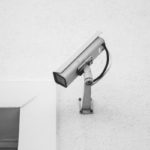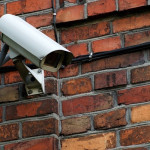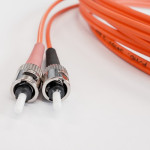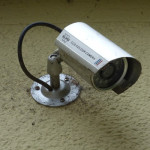Security Cameras Have Come A Long Way
It may be hard to believe, but the video camera has been around for more than 100 years (Fun fact: Thomas Edison helped develop it). A while after its inception, a handheld version was created, making cameras small enough to be out of sight. This technological advancement then spurred the beginning of video surveillance.
Before there were internet-connected cameras, there was Closed Circuit Television (CCTV). For a long time, CCTV was the security camera. CCTV security cameras were installed and directly connected to monitors. Then, you could either pay someone to monitor your camera feed or review recordings after the fact. Neither of these options was ideal – the former was costly, while the latter was not helpful in preventing incidents.
Luckily, improvements in technology have made it easier and more affordable to employ surveillance systems. We can now access live feeds from our security cameras remotely, which would not be possible without the advent of wireless security cameras and IP cameras. Here are some of the more prominent milestones of security cameras.
Streaming vs. Recording Cameras
As mentioned, most wireless security cameras these days are streaming live footage rather than using CCTV. It was about 20 years ago when IP cameras entered the market and changed the security industry. At this time, the video quality and technology were not yet up to par, but over time that changed. Continuing advancements brought forth IP cameras with high quality video along with the ability to stream online and control cameras remotely.
Hazard Detection
Video Content Analytics were first introduced about 10 years ago. The integration with security cameras enables multiple functions:
- Motion Detection: recognizes when a image changes as new subjects enter the field of view.
- Auto-Tracking: camera can follow a specific subject automatically.
- Smoke/Flame Detection: recognizes hazardous conditions related to fire to possibly prevent excessive damage.
- Tamper Recognition: camera offers real-time notification and works to suppress surrounding noises when tampering or disturbances are detected.
- Shape Recognition: allows face recognition to automatically identify people that enter the field of view.
Laser Focusing
One of the challenges with security cameras was poor footage with dark, unfocused recordings. Fortunately, laser focusing was introduced and provides better picture and recording in limited lighting environments. Security cameras that have laser focusing deliver improved zoom and picture quality as this feature enables nearly immediate focusing via laser. Infrared technology also improves visibility in dark conditions (much like night-vision goggles).
For a great selection of quality security cameras and surveillance systems, visit SecurityCamExpert.com or call 888-203-6294. You can also connect with us on Facebook, Google+, Twitter, LinkedIn, and Pinterest.
Smart Homes 2019: What To Expect
We have seen smart technology take over many aspects of our lives. From smart phones to smart watches, smart technology continues to improve our day to day living and is spreading to our homes. A smart home incorporates smart technology into your house for added convenience and security among other benefits. Find out how you can start turning your house into a smart home this year.
Lighting
This is the most common way that people ease into smart home technology. Smart lighting allows you to set a timer for your lights and control them through an app or possibly link them to your own voice assistant. But smart lighting is more than just convenience. Adjusting lighting when you are away from home helps to deter burglars by making it appear as if someone is home.
Cameras
Security cameras also act as a deterrent, ensuring that your property is monitored and informing potential trespassers that they are being watched and recorded. Should they proceed anyway, you are equipped with video evidence of the burglary.
Smart surveillance cameras, often equipped with high definition technology, can be installed anywhere in or around your home. When motion is detected, these security cameras can automatically begin recording and send you an alert via smart phone or device when this happens. Some smart cameras even employ facial recognition to inform you when certain people have arrived home or an unknown visitor is present.
Leak Detection
You also want to protect your home from damage, which is why smart leak detectors are growing in popularity. These alert you when water is detected where it shouldn’t be, preventing costly water damage and enabling you to address broken appliances or burst pipes immediately. Considering the cost of damages that you may be preventing, investing in these leak detectors is a smart choice.
Fridges
While not necessary, smart fridges offer a range of innovative and convenient features:
- Transparent doors to easily see what’s inside without opening the door
- Doors that open as you approach
- Frost-free smart drawers
- Interior cameras which can be viewed remotely so you can check inventory while you’re out
- Interactive touch screens for communicating, pinning notes, and even watching films
Doorbells
Much like a smart camera, a smart doorbell allows you to see who is at your door via your smart phone, with additional security features:
- Alerts when someone rings the doorbell
- View live footage from your front door
- Hear and speak to visitors
- Record video remotely to watch back as any time
- Motion sensor alerts when visitors don’t press the doorbell
Which smart home trends have you adopted already? Which smart home trends are you considering? Share with us on Facebook, Google+, Twitter, LinkedIn, and Pinterest.
For a wide array of security cameras and CCTV surveillance equipment, please visit us at SecurityCamExpert.com! To learn more about our installation services, or request a free quote, please call 888-203-6294.
Choosing Security Cameras
The holidays are here and heightened home security may be on your mind. The potential for theft or vandalism is always present, regardless of your “safe” neighborhood. Protect your loved ones and your property with a security camera system tailored to your needs.
Getting Started
Before you start shopping around, it’s best to evaluate your security needs. Will you be using your security cameras indoors, outdoors, or both? Do you need a specific area covered, such as the front door, or would you prefer complete coverage of your property?
You also want to consider how you will use your cameras. IP security cameras enable remote access as the feed is broadcast over the Internet, and are a great option if you need to access your feed throughout the day while you’re away. You may also allow other people to view the feed (ex. roommates, family).
Once you have a good understanding of what you want and need, the next step is finding the security solution that fits. One thing that is a must for all security camera systems is quality night vision. You should be sure that video recordings are high quality enough that you can identify faces or license plates during the day or night.
Battery-Powered Cameras
Battery-powered security cameras can operate as standalone units, making them an ideal choice for those who do not need multiple cameras. Because they can be single-camera systems, they are usually more cost-effective than other surveillance options. They are also easy to install as they do not require running any wires or any physical modification to the location in which they are installed (with the exception of some models that require mounting screws to a base). This allows for convenience and flexibility, making it easy to relocate these cameras with minimal trouble.
These cameras are a smart option for apartments or rental properties, and most of these cameras provide special features such as motion detection alerts, automatic recording or motion, audio recording, or even two-way audio communication.
You should keep in mind that these security cameras will require a change of batteries from time to time. Also, these are often Wi-Fi IP cameras and require a stable internet connection for proper transmission and functioning. Without a stable network connection, video quality and access of your feed remotely via app may be compromised. In addition, you may need to factor a cloud storage fee in to your budget, depending on the camera you choose.
Hybrid Cameras
Hybrid security cameras are Wi-Fi cameras that operate via AC power cable, therefore, do not need to have batteries changed, and can be placed anywhere with a rare need to be accessed again.
Because they require AC power, they need to be placed relatively close to an outlet. And if you are looking to install a multi-camera system, this needs to be considered as you should have one available plug per camera and enough cable to reach the unit.
Much like the battery-powered units, these IP cameras transmit the video feed over the Wi-Fi network so they require a strong connection. The difference, however, is that some hybrid models use a local hard drive to store footage, allowing you to bypass cloud storage and fees.
In addition, these cameras may offer motion detection push notifications and recording, as well as audio recording and real-time two-way communication.
Wired Surveillance Cameras
Hard-wired cameras offer the greatest stability since both their power and video feed are transmitted via wires instead of battery or Wi-Fi. Because of this, these surveillance cameras are ideal for areas with high signal interference or unstable connectivity.
Some models provide Power over Ethernet (PoE), which means power and video are both transmitted through the same, single wire. This is helpful for those looking to install multi-camera systems for the entire home as it cuts down on numerous long distance cable runs. But in comparison to the battery-powered and hybrid solutions, these cameras require a more involved installation process thanks to the cables and wiring.
On the upside, wire transmission enables the file size and quality to be significantly higher (up to 4K). Because these are typically multi-camera surveillance systems, they are best suited for outdoor application or whole home or business solutions.
As far as storage, these systems require hard drives to compile and store the footage from various feeds. Storage requirements will depend on your individual needs. You must consider file size as well as how long you want to store your footage before it is overwritten.
If you need help determining how much storage you will need, or simply need help choosing the right surveillance system for you, please contact us 888-203-6294 or visit SecurityCamExpert.com. You may browse our selection of top quality security cameras and surveillance equipment, or inquire about our installation services, site surveys, or request a free quote! You may also connect with us on Facebook, Google+, Twitter, LinkedIn, and Pinterest.
Home Security: Mistakes To Avoid
You may think you are taking all the necessary precautions to keep your home safe, but you may be unaware that you are making some simple mistakes. Here are some common missteps that may be putting your home at risk.
- Location
Sometimes the location of your house can influence your risk for burglary. If your home is located on a busy street with high-visibility, you have less chances of your home being targeted – there’s simply too much risk of being seen and caught in the act. Unfortunately, better burglary targets are townhomes, houses in the middle of the block, and homes on cul-de-sacs. If your property backs up to a forest, open lot, or other unguarded area, be sure to take the necessary precautions and install high fences and lots of lighting. - Garbage
Did you know electronics are second to cash when it comes to the things burglars look for? Don’t leave big boxes from your expensive electronics visible from the street. This is a telltale sign that you’ve got shiny, new electronics ripe for picking. Take the extra time to break down the boxes and make sure labels cannot be seen. - Mail
An overflowing mailbox is a sure sign that someone is out of town. The same goes for newspapers piling up on your driveway. You can arrange for someone you know and trust to pick up your mail or place a temporary hold on your mail and newspapers while you’re away. - Yard
Your yard can give away many clues as to what may be inside your home. Before you go on vacation, be sure you have mowed the lawn and trimmed your bushes and that you have a plan to upkeep these appearances until you return home. Burglars will pay attention to uncut lawns, and overgrown bushes allow for a place to easily hide. In addition, if you live in an area where snowfall is possible, arrange for someone to create car and foot tracks into the house.If your children’s toys are left out, they are at risk of being stolen, and they give burglars insight to what type of valuables they may find inside. With children present, there may be an expensive gaming console or other electronics, and mommy and daddy may have expensive jewelry hidden away inside.Lastly, you don’t want to make it easy for thieves to access your home so be sure to put your ladder and tools away and refrain from leaving stools or chairs in your backyard. This makes it easier for them to gain access to a second story window that may not be locked. - Lock Up
Speaking of locks, more often than not, burglars enter homes through unlocked doors and windows. So it is worth mentioning – Do not forget to lock your doors and windows. And that goes for all doors or entryways, such as the front and back doors along with the garage doors. Whether your garage door leads into your home or backyard, be sure to lock it because the bad guys will try anything and everything to get to your valuables.And because they will try anything, do not forget to secure your dog door while you’re away. And you may forget, but it’s smart to secure patio doors as well since they are fairly easy to pick. The easiest and most inexpensive way is putting a heavy duty stick in the door track, however, there are locks which fasten along the top and bottom of the door and are less of an eyesore and inconvenience. - Windows
Much like doors, windows provide another point of entry, albeit less convenient. You may want to crack a window to cool down the house without cranking the A/C, however, if you neglect to close it when you leave, you are making is too easy for someone to enter your home. Along the same lines, if you have a window A/C unit, it is easy for thieves to knock it out and climb in through the window.Aside from locking them, you should consider the visibility of the inside of your home from your windows. You should leave a mix of open, partially open, and closed blinds, but choose wisely. Avoid leaving blinds open near your valuables and electronics. Leaving some blinds partially open allows for some privacy and security while letting interior light out, and vice versa. - Keys
Leaving a spare key around in case of emergency is a good idea in theory, however, thieves are often privy to the usual hiding spots. If you must hide a spare key, avoid the obvious areas and think outside of the box.Additionally, don’t keep your keys on a hook next to the door nor should they be visible from outside. And do not keep your garage door opener in your car. Whether your car gets broken into at home or elsewhere, the burglar knows your address is printed on the registration card. Invest in a keychain remote for added security. - Visitors
Be wary of those you invite into your home. Whether they are friends of friends or hired help, word can spread quickly about what’s inside your home. While those who enter your home may not be thieves themselves, they may pass information along to someone looking for some quick cash. - Social Media
Social media is a tricky thing. While you want to share highlights from your vacation with friends and family, be sure you are being smart about it. Refrain from posting those vacation photos as it clearly tells others that you are away from home, making your property a prime target. Instead, be sure your profiles are not public and wait to post those vacation pictures until after you have returned home.
Do you have any other home security tips to share? Connect with us on Facebook, Google+, Twitter, LinkedIn, and Pinterest.
For an affordable, quality home security system, visit SecurityCamExpert.com or call 888-203-6294! We are happy to provide you with a free quote, schedule a site survey, or assist you with any questions you may have.
What You Need To Know About Wired Security Cameras
So you’ve been debating between wired and wireless security cameras and you’ve finally made a decision to install wired security cameras. Here’s what you can expect:
Additional Equipment
When you purchase a wired security camera system, it will likely come with a DVR box, security cameras, and sometimes the necessary cables. However, the monitor, mouse, and keyboard (all of which are required for a wired security system) will need to be purchased separately.
Unless you have these items sitting around your home, it’s important to factor the cost of these additional items when you are shopping for a system. The only way you may be able to get around this is if you were to connect your cameras to a NAS that is already managed from your computer.
Cable Planning
Your security cameras need to be directly connected to the DVR box, therefore, you will need to be creative with how and where you will run cables across your home. Where you mount your cameras and the location of your DVR box will determine the cable routes. If you are doing this yourself, there are a few things to keep in mind.
Before beginning, make a plan and know the exact layout of your house. Also, find out if anything is in between your walls such as insulation or fire blocks that could potentially hinder cable runs. Map out your cable route before beginning the process, and invest in the proper tools to help you accomplish this task.
The Dirty Work
Again, if you will be installing your wired security camera yourself, be prepared to get your hands dirty. If you’re lucky, you may be able to simply run cables down through the floor, across the basement, and up through the floor on the other side of the house. However, you may be required to crawl through attics and crawlspaces. With that said, wear the appropriate attire and invest in good knee pads to protect yourself.
Network Connection
The benefit of having a wired security camera system is that you don’t need to connect it to the internet for it to work. The downside is that you cannot access it remotely when you’re away from home. While keeping your cameras off of the internet can be a safer bet, if you want to view your feeds remotely, you may want to consider connecting your cameras to your network.
If you need help choosing a wired security camera system and installing it, feel free to call 888-203-6294 or visit SecurityCamExpert.com. You can also connect with us on Facebook, Google+, Twitter, LinkedIn, and Pinterest.
Cloud Video Storage
It’s likely that you have heard about the cloud and may already use its services in various aspects of your life. But did you know it can improve your surveillance system and storage?
Cloud storage allows you to save your video footage remotely and access it online. You may use cloud storage in lieu of, or in addition to, saving your files locally, whether on an NVR or computer hard drive.
By utilizing cloud storage, you gain access to numerous benefits. Here are some of the biggest and best benefits of cloud storage.
Storage Space
You get more storage space by using the cloud. This means prolonged retention of videos which can be helpful for evidence purposes. If you use cloud storage in addition to your NVR or computer hard drive, you allot yourself even more potential storage space.
There are NVRs that are specifically designed to work with cloud storage, which contain a small hard drive that stores videos locally before uploading them to the cloud. Just remember that the uploading process can slow down your network. If possible, NVRs with a cloud service that allows you to upload videos on a schedule is ideal. This will enable you to schedule uploading during off-peak hours, such as nights, early mornings, or weekends, to offset the impact on your network.
Added bonus – since your data files are not stored locally, in the event that your equipment is damaged or stolen, your video footage remains safe.
Remote Maintenance
Because your cloud storage solution is managed offsite, you won’t have to rely on on-site technicians and appointments to resolve issues. Troubleshooting and maintenance may be performed as needed, minimizing any downtime and allowing for better customer service and support overall.
Accessibility
You may check in on your surveillance system from anywhere, anytime. While other systems may allow remote access, you may have to deal with speed and buffering issues. With cloud video surveillance, built-in buffers and systems keep video playback and streaming quick and clear.
Automatic Updates
Cloud solutions allow for regular updates as needed – you don’t have to do a thing! This ensures that your system safe from potential vulnerabilities and operating at its best.
Scalability & Convenience
As your on-premise equipment requirement is greatly diminished, upgrading and scaling your system is made easier. You can forgo the extensive installation process and expand your system as necessary as your business grows. Also, because most of the equipment is off-site, you can save precious office space.
Stability
By now you should know that cloud solutions are great at self-monitoring and resolving issues with minimal user intervention. With that said, these systems are constantly monitored for stability and have redundant systems that ensure security cameras are always active and recording. And in the case of natural disasters, which may destroy your on-site equipment, your data will be fine.
Cost-Effective
Save money by choosing cloud solutions, which usually offer a low monthly fee for their services. In the long run, this is much more cost-effective than purchasing on-premise equipment, which requires installation and routine maintenance at additional costs.
Do you utilize cloud surveillance solutions? Share the ups and downs of your surveillance system with us on Facebook, Google+, Twitter, LinkedIn, and Pinterest.
For a great selection of CCTV security cameras, systems, and surveillance equipment, please visit SecurityCamExpert.com or call 888-203-6294 today!
Dahua & Hikvision Ban
In case you hadn’t heard, the 2019 National Defense Authorization Act was recently signed into law. The whole process began in May of this year, when the US house passed the bill, and then on August 1st the Senate passed the bill. Several days later, the President made it official by signing it into law on August 13, 2018. The 2019 NDAA has a particular impact on the security industry as it bans both the purchase and use of Dahua and Hikvision and their OEMs in the US government and US government-funded contracts.
Although the Dahua and Hikvision ban will begin on August 13, 2019, the effects of this act are already being felt by Dahua and Hikvision. Stocks for both companies have dropped noticeably since the passing of the NDAA and we can expect further decline. Despite the delayed enforcement, there is no sense in purchasing and using equipment now that will soon be phased out.
Extending the ban to OEMs will eventually trickle down and impact wholesale distributors. Buyers will be concerned with potential security risks, possible issues with prospective integration with public or government systems, and future legislation at the state or local level. In addition, this will impact consumers outside of the US, as negative media coverage may make them feel wary of the security and dependability of Dahua and Hikvision products.
Only time will tell what the true implications of the 2019 NDAA will be. Share your thoughts on the ban with us on Facebook, Google+, Twitter, LinkedIn, and Pinterest.
Visit SecurityCamExpert.com to browse our extensive selection of quality security cameras, CCTV surveillance packages and security equipment for your home or business. If you have any questions or would like a free quote, please feel free to contact us 888-203-6294.
CCTV Surveillance Cameras: Maintenance & Troubleshooting Tips
After you purchase and install a home security camera system, it is important to maintain it in order to preserve its quality and performance. From the surveillance cameras to the cables to video storage, all parts must be working properly to ensure optimal surveillance and security. Here are some helpful maintenance and troubleshooting tips for your surveillance system.
Maintenance
- Hard Drives
Check your hard drive regularly by simply playing back recent video. To make sure your cameras are properly recording, check the field of view and filter through different dates and times. Make sure you are getting the proper recording duration. A surefire sign that something is wrong is if the duration of footage stored has significantly decreased. For example, you used to get weeks or months of footage, but now it seems you are only getting a few days worth.
- DVR & Security Cameras
Cooling fans assist in preventing your DVR from overheating. Unfortunately, when they suck in the cool air, dust begins to build up as well. The accumulation of dust can damage the fan, resulting in overheating. Cleaning your cooling fan regularly can prevent this and is relatively easy. Computer dust sprays are available at many computer stores and you simply aim at the vent areas and spray.
The IR (Infrared) lights on your security cameras tend to attract spiders and bugs. Because of this, spiders tend to build their webs around the cameras in order to catch the bugs attracted to the light. Consequently, these spider webs interfere with your videos. Check your playback or live feed to see which cameras are affected. If you cannot kick the problem, it may be better to use cameras without IR and install a separate light source to illuminate the area.
Every so often, you should use a soft cloth or wipe to remove any dust or debris and clean the camera lens. A dust mop with a long handle can help you reach higher mounted cameras that are typically out of reach.
- Day/Night Recording
Camera sensors and other parts can wear out over time and will eventually need to be replaced. In addition, camera connections may need maintenance as environmental factors such as heat, cold, and moisture can affect them. If you see any signs of connections issues, such as lines in the image, flickering or other image issues, you should address these immediately to prevent further damage or total image loss.
Troubleshooting
Issue: Security cameras are out but the DVR is working.
- Restart the camera power box.
- Make sure the power box has power.
- Look for lights on it (sometimes these are inside the box and may be difficult to see).
- Many larger boxes have fans so look for signs of life.
- If these don’t work, schedule a service call as it may be a power box issue (although rare, power boxes sometimes go out).
Issue: DVR or NVR is not reachable by Internet (no phone or computer access).
- Did you reset your router to default or get a new router? If yes, then this needs to be repaired professionally.
- Try restarting your DVR and router as well as any other network devices (ex. network repeaters, adapters). If this does not resolve the issue, you may need professional assistance.
- Check all connections – make sure that the internet connection is firmly in place behind the DVR as well as in the router. These can come loose, especially when cleaning around the DVR or relocating something nearby that may have pulled the cord out.
Issue: DVR is not playing back video.
- Try rebooting the DVR (the rule of thumb for any issue with electronics).
- If that does not work, it may be a bad hard drive. Check the DVR and see if the hard drive is showing up in the settings. If not, this is a definite issue and you will need to replace your hard drive.
If you need help choosing the right security cameras for your property as well as installation services, feel free to contact us! You may browse our selection online at SecurityCamExpert.com or call 888-203-6294 to schedule a site survey or get a free quote. You can also find us on Facebook, Google+, Twitter, LinkedIn, and Pinterest.
Security Camera Cables: Ethernet Vs. Fiber Optic
When installing a new surveillance system, whether at home or for your business, there are many factors that need to be considered. Aside from choosing the proper security cameras, devices, and management software, security camera cables are important and often overlooked.
Security camera cables are crucial to your surveillance system as they are responsible for power and data transmission within your system. You will likely be upgrading your system from analog closed-circuit television (CCTV) to an Internet protocol (IP)-based system. Thanks to special parts called encoders, if you are only upgrading your legacy system, you can keep your analog cameras and coaxial cabling in place. The encoders convert the analog output of the camera for use by an IP-based security system.
Alternately, if you are upgrading to IP cameras and want to keep coaxial cable in place, you would need to install adapters at both the device and the switch (coaxial cable cannot handle the digital output of the cameras).
Encoders and adapters are merely affordable, short-term solutions. And because they introduce new points of failure, they can become costlier in the long run.
IP Camera Systems Cables
Upgrading your system includes your security camera cables as well. For IP-based systems, there are two choices: Ethernet (copper) cable or fiber optic (glass) cable.
Ethernet Cable
Made from twisted copper wires, Ethernet cables carry data using an electrical current. Cat 5e is currently the most commonly used in home applications and can support speeds of up to 1,000 Megabits per second (Mbps) over 100 meters (m). Cat 6, 6a, 7, and 8 cables are more commonly used in business and data centers as they can handle larger data transfers, ranging from 10-40 Gigabits per second (Gbps).
Fiber Optic Cable
Fiber optic cables use light to send digital data along flexible, optically pure glass or plastic fibers that are about the width of a human hair and enable rapid movement of data. There are two types (single or multimode) which determine the speed and length of data transmission. The differences between the two types are significant and dictate how each is used.
- Single-Mode Fiber
Because it has a narrow core of optical glass surrounded by highly reflective cladding, single-mode fiber only carries data via a single mode of light (typically transmitted by laser). This allows for lower attenuation (data loss) over longer distances and, thus, is ideal for use in high bandwidth runs (ex. telecom and communications companies, college/university campuses).
- Multimode Fiber
Multimode fiber has a larger core, allowing several different light signals (more data) to pass through simultaneously. With a larger core comes narrower cladding, which results in more data attenuation. With that said, multimode fiber is better suited for shorter distances (ex. transmitting data and signals across a local area network).
Ethernet Vs. Fiber Optic Cables
Choosing between the two options will depend on your individual needs. Here’s a look at the strengths and weaknesses of each.
Data Handling, Speed & Distance
- Ethernet cable has improved over time, with the Cat 7 and Cat 8 able to support up to 25 Gpbs to 40 Gbps over 30 m runs. Unfortunately, regardless of category, copper has a much higher attenuation rate, which only increases with the distance of the run. Thus, you would need to install an amplifier or repeater for every 100 m (328ft) of cable.
- Fiber optic cables are the better choice, as multimode cables can reliably handle 40 Gbps and up to 100 Gbps depending on the quality of the cable. Speed and distance depends on the light mode, but fiber can reliably transmit data between 610-2,000 m (2,000-6,562 ft) before the signal requires amplification.
Usability, Safety & Security
- Ethernet cabling is straightforward and ideal to use in tight spaces since copper is a flexible metal and can bend a great deal before it succumbs to the stress. However, these cables pose very minimal fire hazard risk, particularly if they are used to carry power to a device (such as an outdoor security camera). And if you are running Ethernet cables to outside cameras (ex. on light poles in parking lots, at the edge of a property), there is also a risk of attracting a lightning strike. In addition, they also post a security risk since they tend to leak data, and are also susceptible to outside interference (ex. electrical sources, other data cables).
- Fiber optic doesn’t radiate data signals at all and provides good security, but it’s not without its faults. Because it is made of glass, despite its flexibility, there is a chance for breakage if bent too far. There is also a greater chance of damaging the cable during installation or during some later construction, and it is difficult to properly splice it. These concerns should be raised with vendors you speak to before purchasing.
Cost
- Ethernet is more affordable in the short term. The cable, its components, and installation tend to be cheaper thanks to its ease of use. However, these tend to require more regular maintenance, thus increasing ownership costs over time.
- Fiber optic is definitely more expensive up front, as cost of cables (especially single mode) and installation are much higher. Despite this, it has a lower ownership cost over time thanks to less maintenance (compared to copper). Also, the cables can more easily handle expanded bandwidth without having to run new cable.
While both Ethernet and fiber optic cables have their advantages and disadvantages, it really depends on your security needs. Have you chosen between the two? Share your experience with us on Facebook, Google+, Twitter, LinkedIn, and Pinterest.
For a great selection of CCTV security cameras, systems, and surveillance equipment, please visit SecurityCamExpert.com or call 888-203-6294 today!
Prevent Blind Spots In Your Surveillance System
Security camera systems are meant to protect your property from intruders and collect crucial footage should any incident occur. Unfortunately, if not properly planned, your surveillance system may have blind spots that can be problematic. Blind spots are specific areas that are not in the field of view of your CCTV cameras. These blind spots leave your home vulnerable to intruders who may take advantage of these to gain access or damage your property.
Here are some useful tips to avoid blind spots within your surveillance system.
Take A Picture
Visualizing what you want to cover will help you plan where to place your cameras for optimal coverage. You can use these images as a reference to consult with experts on which type of security cameras, lenses and specs would be best for what you are trying to achieve.
Have an existing system? Test your camera’s FOV (field of view) by having a friend walk through your home while you monitor the live feed.
What Do You Want To Capture?
Prioritize what features are absolutely necessary and the ones that are optional. Also, consider the camera locations and what your goal is for each area. This will help you determine the appropriate resolutions for your different cameras.
Consider Natural Environment
Whether you are installing your security cameras indoors or outdoors, you must consider natural elements of the environment. From daylight to reflections to inclement weather, these elements can noticeably hinder your footage, sometimes even rendering it useless.
To avoid these issues, pay close attention to camera angles and placement. Be sure that there are no potential obstructions, such as branches, trees, or décor, in your camera’s FOV. Invest in cameras that have day/night vision and lenses that can automatically adjust themselves to provide the best picture. And lastly, for your outdoor surveillance, choose weatherproof cameras and/or weatherproof camera housing to protect your equipment from unpredictable weather conditions.
Vandalism Potential
Intruders will often look for cameras and their first instinct is to destroy them in hopes that they can wipe out or prevent evidence of their crime. To prevent this, install cameras high and out of reach when possible, and seek out cameras that are vandal proof.
Location, Location, Location
As previously (and repeatedly) mentioned, the placement of your cameras is crucial to eliminating blind spots. If you are having trouble planning and strategizing your security cameras, or simply need expert advice, feel free to contact us at 888-203-6294.
Do you have your own security camera system advice to share? Connect with us on Facebook, Google+, Twitter, LinkedIn, and Pinterest!
Visit SecurityCamExpert.com to browse our vast selection of quality CCTV surveillance and security camera systems at affordable prices. We also offer site surveys and installation services. Contact us for more information.









